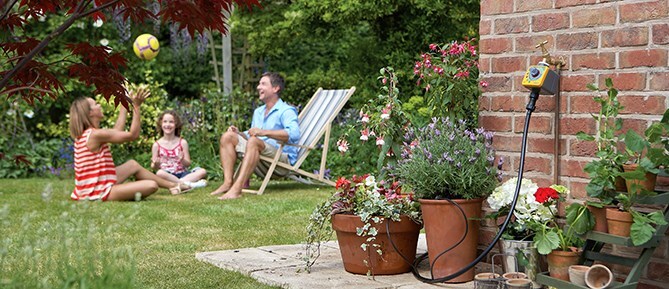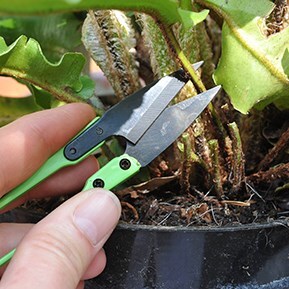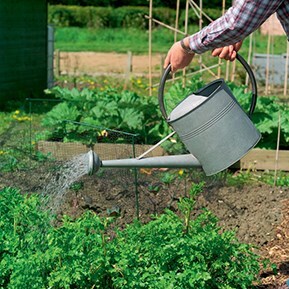Holiday Survival Guide

You can forget Jaws, Dracula and Frankenstein, every gardener’s nightmare is to return from holiday to find their prized plot Possessed. Leave a garden for a fortnight and the greenhouse becomes a breeding ground for Alien-looking beasties, Zombie weeds run amok in beds and borders, and the kitchen garden becomes a Waste Land as vegetables run to seed and fruit hangs rotting, still waiting to be picked. But don’t let these nightmarish scenes scare you. By taking the right precautions before you go, you can keep your garden gently ticking over until your return.
Garden holiday checklist
- Transfer all containers into the shade
- Rig-up automatic watering systems where practicable
- Move houseplants off sunny windowsills
- Water and mulch drought-susceptible plants
- Deadhead repeat-flowering bedding and pick sweet peas
- Harvest ripe tomatoes and large cucumbers in the greenhouse
- Pick over peas, beans and courgettes
 If this is sounds too Heath-Robinson for your liking, you could always invest in a trickle irrigation system and plumb in your pots and baskets before you go (see ‘Watering made easy’). It is also worth deadheading all repeat-flowering bedding plants, including all the flowers that are open. Instead of producing seed, this will encourage them to put their energies into further flushes of flower on your return.
If this is sounds too Heath-Robinson for your liking, you could always invest in a trickle irrigation system and plumb in your pots and baskets before you go (see ‘Watering made easy’). It is also worth deadheading all repeat-flowering bedding plants, including all the flowers that are open. Instead of producing seed, this will encourage them to put their energies into further flushes of flower on your return.
Houseplants Cacti, succulents and house plants with fleshy or waxy leaves, are well-adapted to surviving periods of drought so won’t even notice you have gone away. Given a good drink, many others will be able to cope for a week or two of neglect, provided they are moved from sunny windowsills. Those than require more pampering can be stood on capillary matting placed on the draining board with one end of the matting dangling into the sink. Simply fill the sink with water before you go, so that the matting remains soaked and the plants can water themselves. Larger containers can be stood in the bath on capillary matting with the tap left dripping to keep the matting soaked. Pots with crocks in the compost or pronounced rims on the base, will need capillary tails pushed into the drainage holes to draw up the water. Remember that all pots will need to be watered from above before you go to get the capillary action going. If you go away a lot, you might want to invest in self-watering pots that have built-in water reservoirs, for your prized specimen plants.
Beds and borders Established garden plants will not need watering while you are away, but specimen trees and shrubs planted earlier this year as well as new bedding and perennials that are yet to establish will suffer if they are allowed to dry out. By giving each plant a thorough soaking and mulching the surface of the soil before you go will help, but to be sure of survival you will have to call upon that willing gardening volunteer. To keep them on board, you could make watering as easy as possible by laying out leaky hose around the plants that need watering and link it to the outside tap via a hosepipe. Then it’s just a matter of turning on the tap. Where a gardening friend is hard to find, consider making the system automatic by adding a special watering timer that can be pre-set to turn the water on and off. Before you go, repeat-flowering bedding and perennials are worth deadheading to encourage more flowers on your return. Sweet peas, in particular, are worth picking clean of flowers because they tend to stop blooming altogether if they are allowed to set seed.
Lawns If you are going away, there is no need to water your lawn - in fact it would be a bad idea. Applying water will just make the grass grow, so it will be more difficult to cut when you return. Patches of weeds are worth controlling with a lawn weedkiller that doesn’t contain fertiliser, and it is a good idea to give the lawn a good short-back and sides before setting off.
 Fruit and veg Weed control should be a priority, giving the whole plot a careful scuff with the hoe to remove any weed seedlings between rows, finishing off by hand weeding anything lurking really close to the crops. Pick over repeat-cropping vegetables, such as peas and beans, removing all the pods. Although most will be perfectly useable when you get back, leaving pods to mature on the plant with reduce subsequent flowering and future cropping. If you have a surplus after harvest, give them away to friends and neighbours or add them to the freezer. Similarly, if you want a supply of courgettes when you return from holiday, pick all the developing fruits before you go - otherwise you will end up with a one or two prize marrows, but an absence of courgettes for the rest of the season.
Fruit and veg Weed control should be a priority, giving the whole plot a careful scuff with the hoe to remove any weed seedlings between rows, finishing off by hand weeding anything lurking really close to the crops. Pick over repeat-cropping vegetables, such as peas and beans, removing all the pods. Although most will be perfectly useable when you get back, leaving pods to mature on the plant with reduce subsequent flowering and future cropping. If you have a surplus after harvest, give them away to friends and neighbours or add them to the freezer. Similarly, if you want a supply of courgettes when you return from holiday, pick all the developing fruits before you go - otherwise you will end up with a one or two prize marrows, but an absence of courgettes for the rest of the season.
If the weather forecast is set fair, give the whole vegetable plot a thorough soaking the night before you leave. Pay particular attention to potatoes to keep the tubers swelling and leafy crops, such as lettuce, that can run to seed if they are allowed to run short of moisture. Where practicable, you could also mulch the surface of the soil between the rows to help prevent evaporation and keep down weeds. But don’t pile mulch up against the crops or they might rot. Another option would be to enlist the help of that over-worked gardening friend to water and weed your veg patch while you’re away - by offering the reward of free harvests of peas, beans and courgettes you’ll get those picked, too!
Greenhouse Plants in a greenhouse require intensive care and won’t go a weekend, let alone a fortnight without attention. A growing bag filled with tomatoes or cucumbers may require two whole watering cans of water every day during hot spells. Keeping the greenhouse cool will also be a challenge and pests and diseases will be a constant threat. You can control the temperatures by putting up greenhouse shading and installing automatic vent openers on the windows. During hot spells this will not be sufficient, though, so the greenhouse door will need to be opened and the floor and paths sprayed with water to get rid of more heat. Watering can be automated to a large extent using a combination of capillary matting and drip irrigation (see ‘Watering made easy’), but you will still need a friendly face to pop round from time to time to top up reservoirs and make sure it is all working correctly. Rigorous pest and disease control before you go is the best way to prevent problems while you are away. But start early, because control measures can take several weeks to eradicate colonies of red spider mite and whitefly. Pick over crops to remove all ripe and nearly ripe fruit.
Don’t forget security Don’t let all your holiday preparations highlight the fact that you are away to would-be burglars. Leave one or two drought-tolerant house plants on prominent windowsills at the front of the house and screen any holiday watering devices so that cannot be seen from the road. Lock sheds and put away tools – oh, and if the neighbours are still friendly after all your requests for help, ask them to keep a look out.
